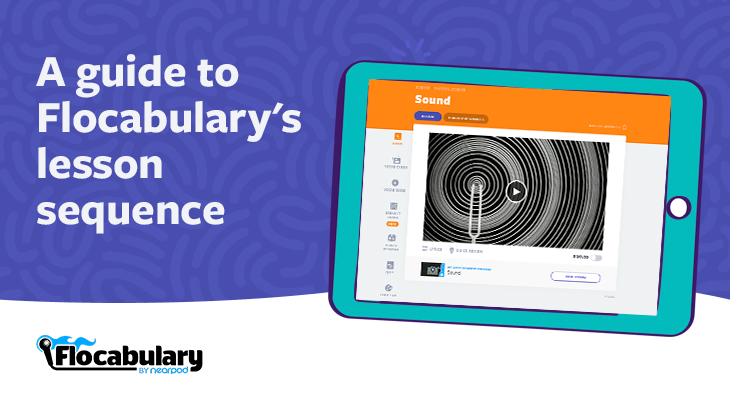
A guide to Flocabulary’s lesson sequence
When lesson planning, one of the most important things to consider is the sequence. Just as we have a scope and sequence at the macro level for curriculum, the same care for individual lessons at the micro level is essential. The lesson sequence determines how students will proceed through the content and skills presented toward achieving the learning objectives.
Flocabulary guides students to higher-order thinking skills through its lesson sequence. Starting with an engaging video to build the foundation, the sequence takes students through activities to reinforce what they learned as well as increase their depth of knowledge so students can apply their learning in meaningful ways.
Here’s an example of the type of engaging videos you can find on Flocabulary!
New to Flocabulary? Teachers can sign up for a trial to access our lesson videos and assessment activities. Administrators can get in touch with us to learn more about unlocking the full power of Flocabulary through Flocabulary Plus.
What is in Flocabulary’s lesson sequence?
Every Flocabulary video is part of a carefully designed lesson sequence. That sequence includes the Video, Vocab Cards, Vocab Game, Break It Down, Read & Respond, Quiz, and Lyric Lab. The activities in Flocabulary’s lesson sequence target different levels of Bloom’s taxonomy, from remembering, to understanding, applying, analyzing, evaluating, and creating.
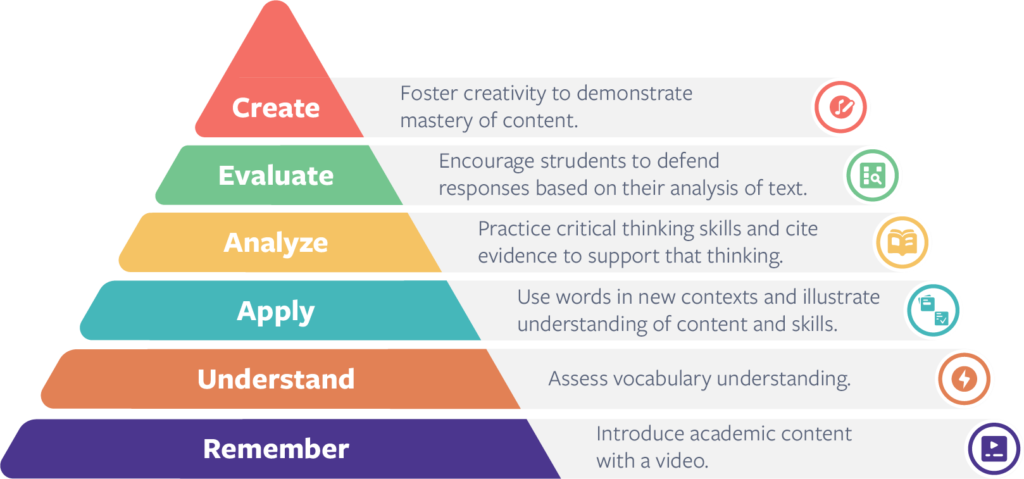
A guide to Flocabulary’s lesson sequence
Video
Flocabulary’s lesson sequence kicks off with a video. Videos in Flocabulary’s Base, Mix, and Nearpod Originals collections are standards-aligned and research based.
- Flocabulary videos are original hip-hop songs that teach content and skills in math, social studies, science, ELA, and life skills.
- Flocabulary Mix pairs a Skill video with a Video text to provide instruction and practice opportunities for a comprehension skill.
- Nearpod Originals uses storytelling, humor, and relatable hosts to teach content and skills in math, social studies, science, ELA, and life skills.
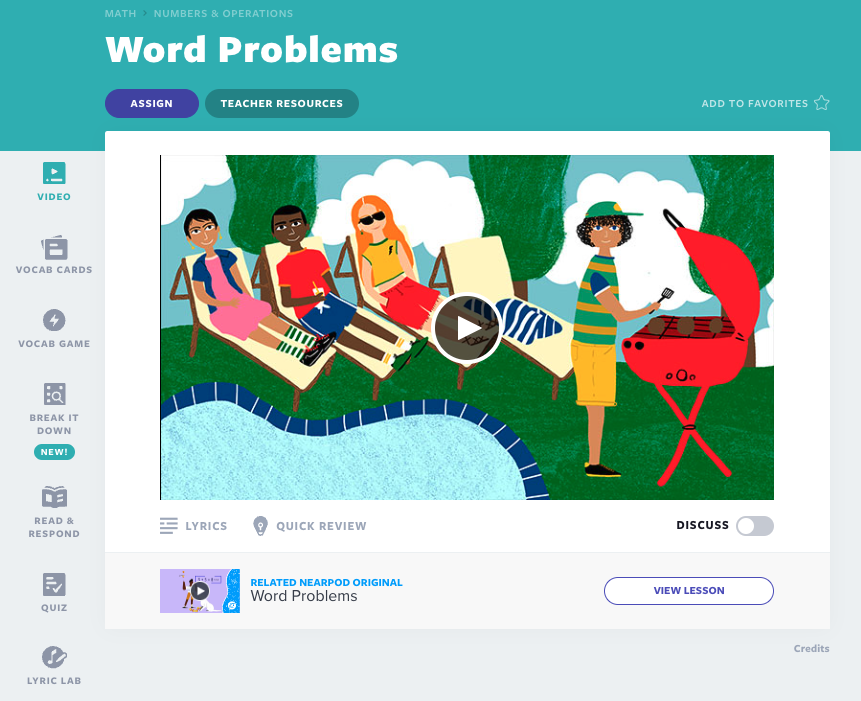
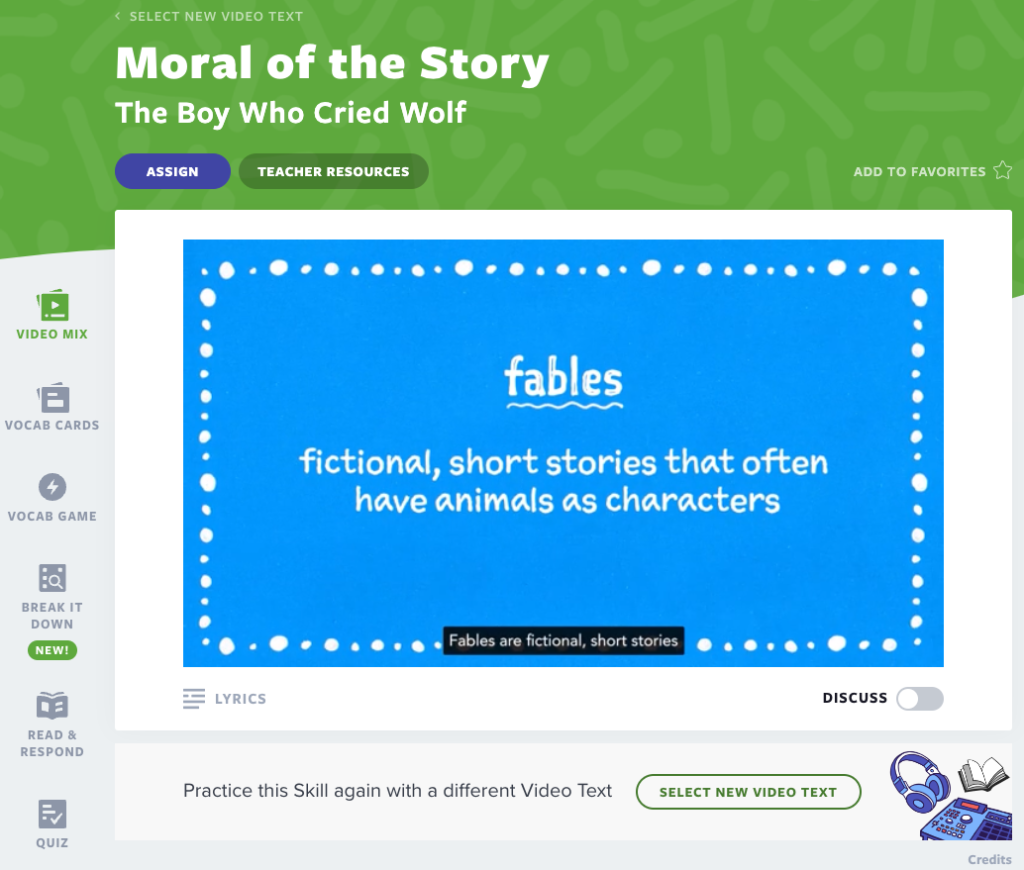
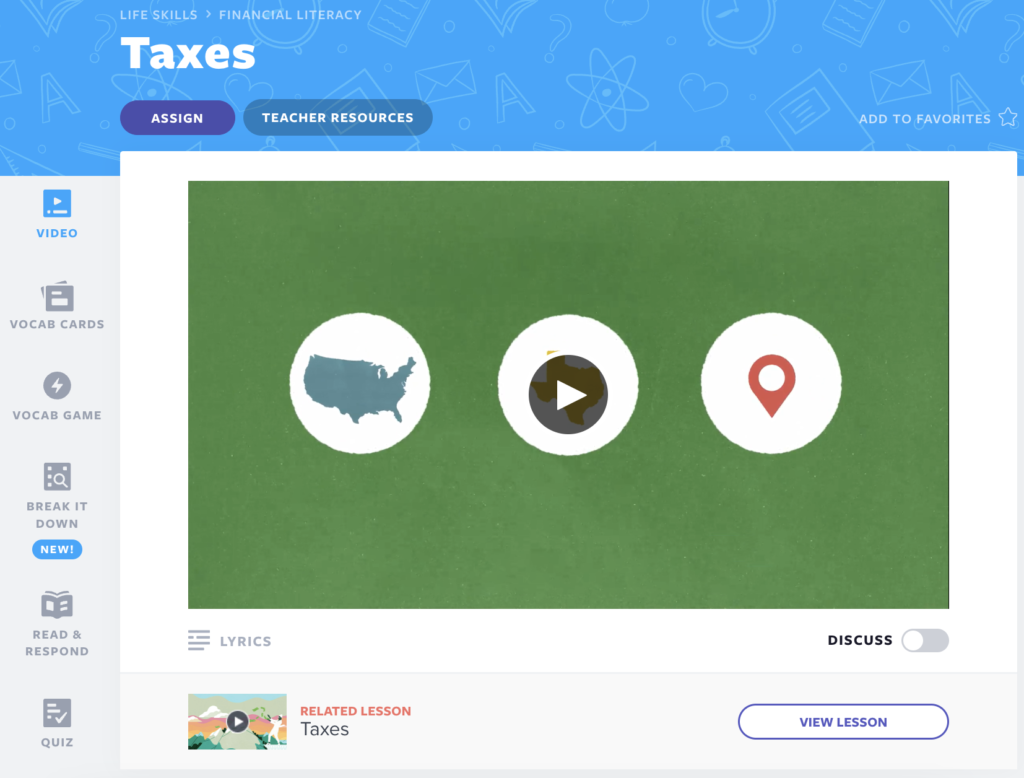
Why start with a video?
Video’s role in the classroom has grown immensely in recent years. With students already turning to video as their main source of information and entertainment, teaching with video makes sense. The video sets the scene for the lesson, building a foundation for students as they start the lesson sequence. It actively engages students with rich, high-quality media created by professional artists and lyricists. The video lessons also come with a Discuss Mode, which pauses the video at key moments to provide questions for discussion and exploration. Students can also use this feature to work in small groups or pairs to discuss with their classmates, for a more autonomous activity. The videos create an interactive learning experience for students, making the lesson content more memorable and readily accessible as they progress through the lesson sequence.
Vocab Cards
Flocabulary’s Vocab Cards provide instruction of key vocabulary terms from a lesson. Each card provides the definition, part of speech, and an example sentence. Vocab Cards also provide images, synonyms, and antonyms when applicable. Vocab Cards are assignable and allow for students to practice using the word in sentences and in a drawing of their own.
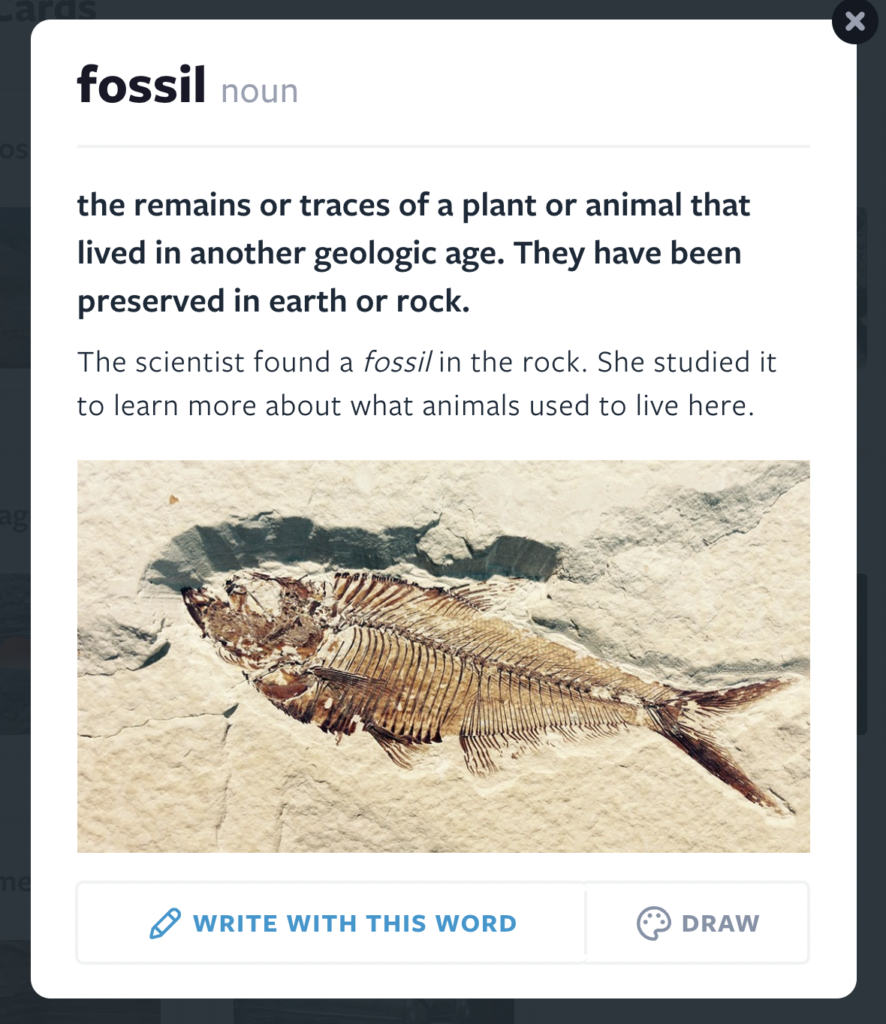
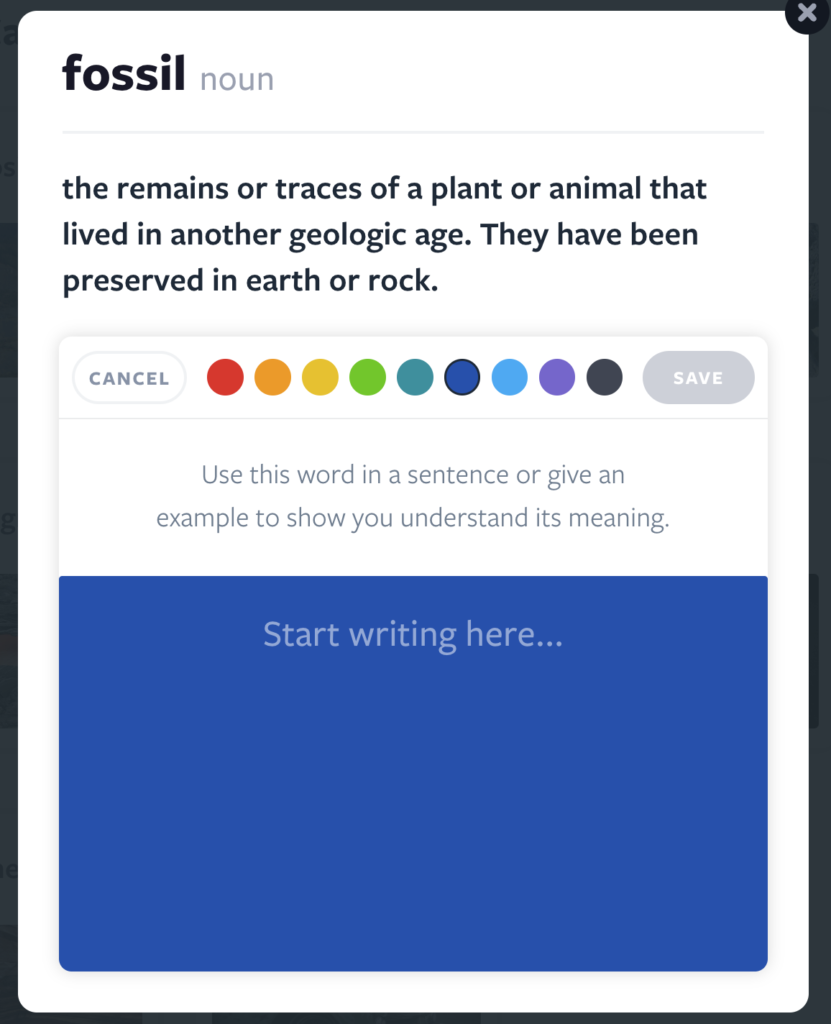
Vocabulary has always been at the heart of Flocabulary’s lessons and activities. Flocabulary uses Isabel Beck and Margaret McKeown’s three-tiered vocabulary categorization system when selecting words to highlight in lessons. We make sure to select words that are essential to comprehension of the text, targeting Tier 2 and Tier 3 words that are the key to the content and skill of the lesson.
For example, the vocabulary terms selected for Flocabulary’s “Types of Rocks” video lesson include words necessary for the context of the topic, such as “weather” and “erosion.” These Tier 2 terms are also applicable to other domains in both informational texts and literature. This video also captures Tier 3 words, such as “igneous” and “sedimentary” which are more specific to the topic at hand.
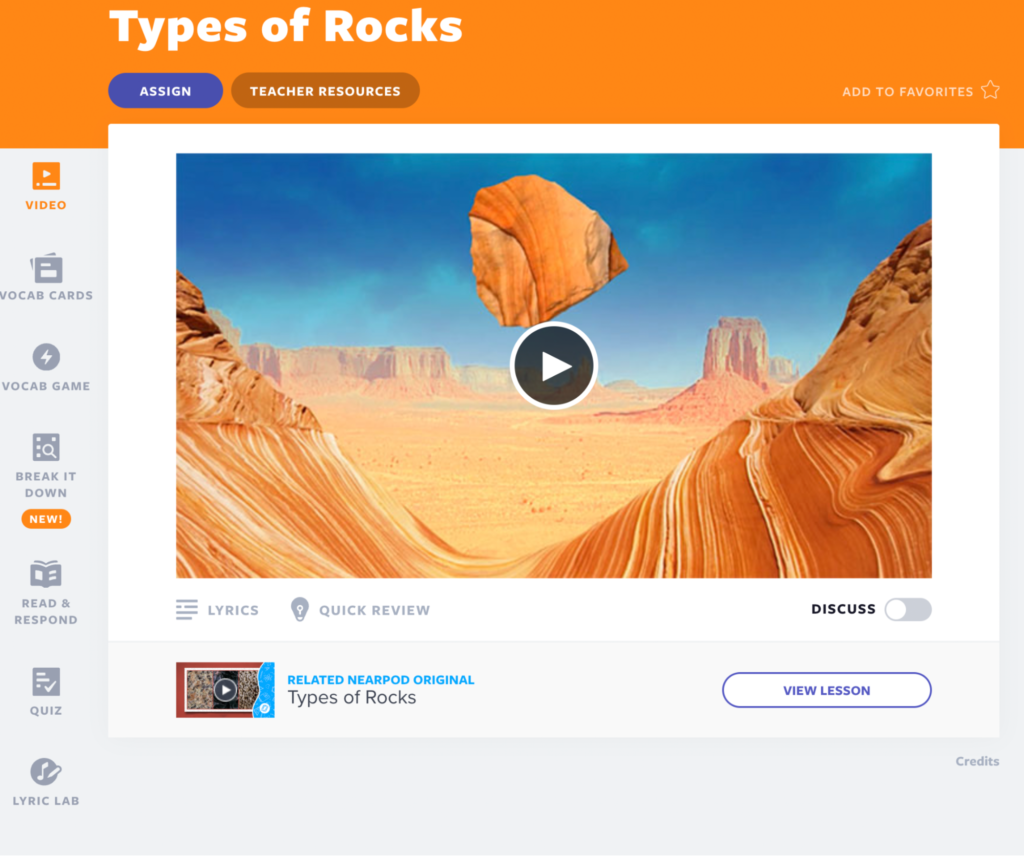
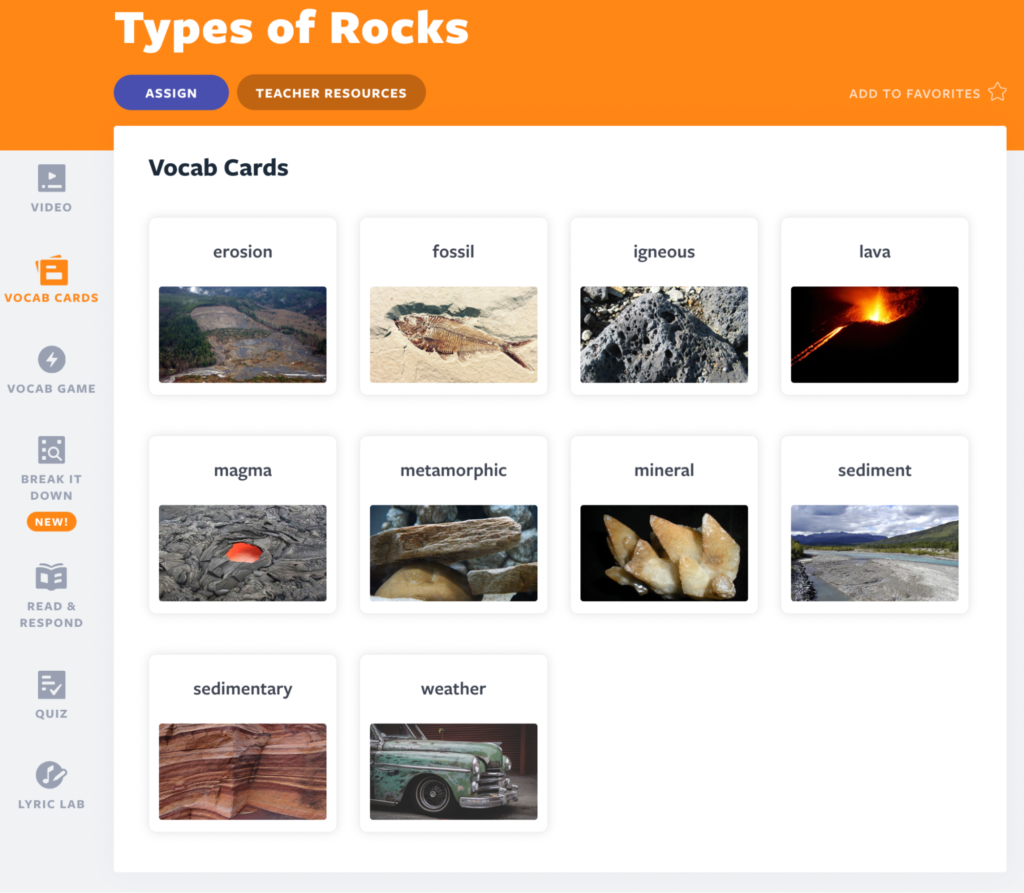
Vocab Cards help provide multiple exposures to vocab words, which are needed for vocabulary acquisition.
Vocab Game
Vocabulary exposure doesn’t stop at Vocab Cards; students get extra practice with Flocabulary’s Vocab Game. In the Vocab Game, correct answers build a hip-hop beat, introducing a new instrument as students answer questions about the lesson’s vocabulary. Vocab Game questions consist of identifying images, completing sentences, matching definitions, and selecting synonyms and antonyms. Students receive immediate feedback, giving them a chance to revisit words.
The Vocab Game also automatically grades, and teachers can assign the Vocab Game to a class. Data collected from the game provides insight into areas for extra review and opportunities for more exposure to vocabulary words. The Vocab Game creates an engaging learning experience through gamification. Research has shown how creating gamified learning experiences fosters learner autonomy, giving students independence and a stronger connection to what they’re learning.
Break It Down
The lesson sequence then shifts to Flocabulary’s Break It Down activity, available as part of Flocabulary Plus. The Break It Down feature is an analysis activity that builds students’ critical thinking skills and strengthens comprehension. Students are guided to analyze the video to find evidence for their thinking. Question types include multiple-choice questions and an evidence selection tool. For students in grades 3 and up, Break It Down also adds an open-ended question to motivate students to think critically and deepen their understanding of the video.
Take our video on “Larry Itliong,” for example.
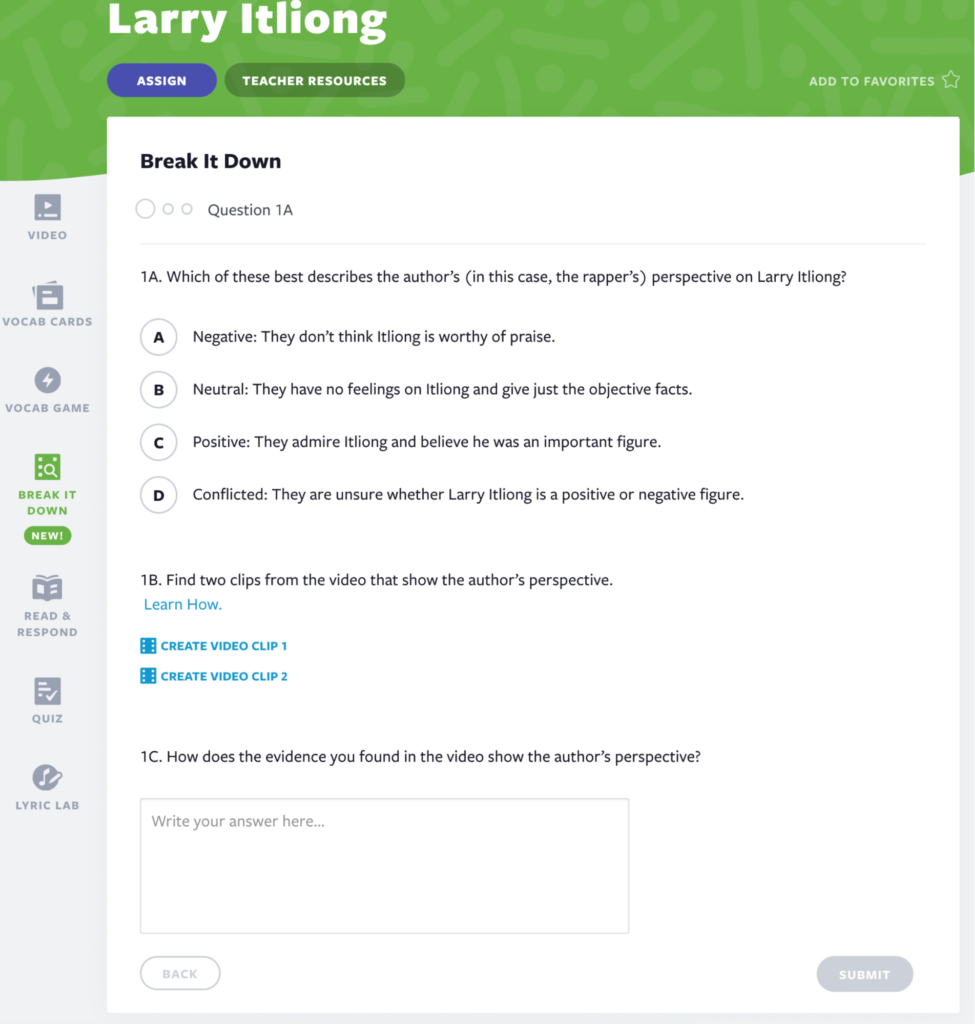
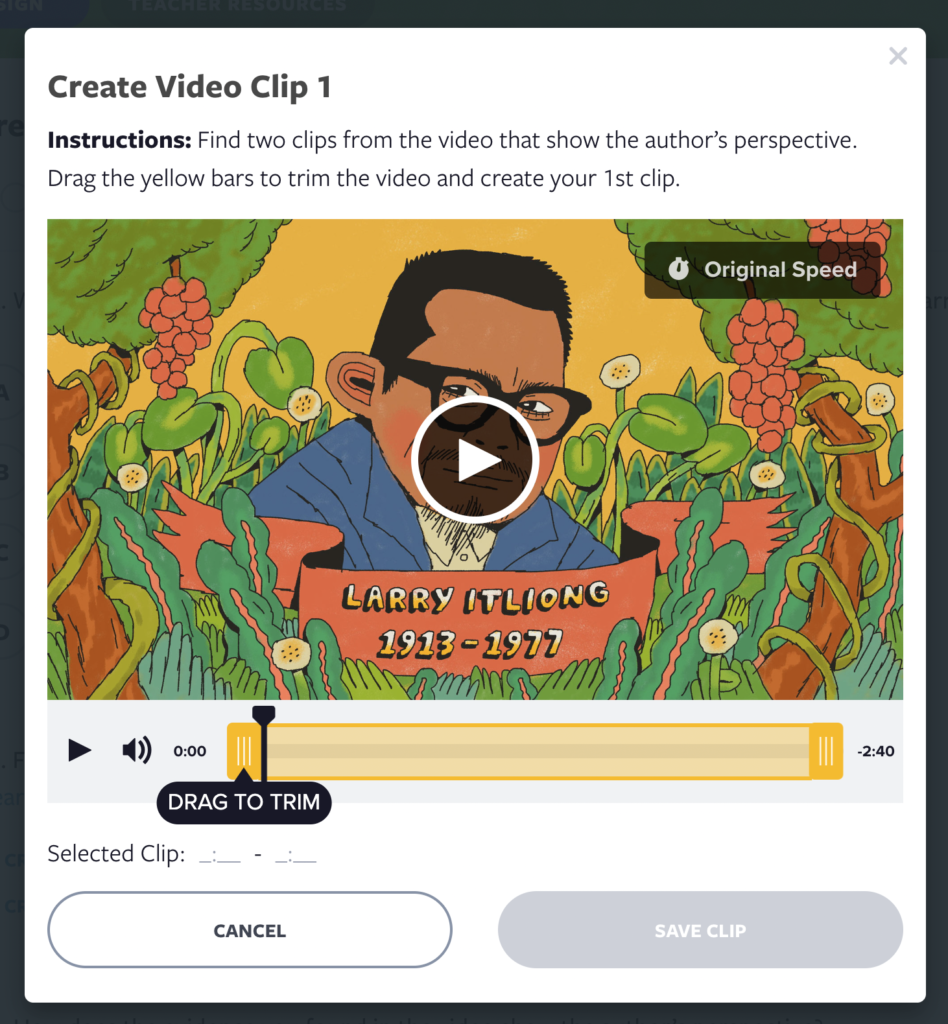
This lesson guides students to consider the author’s perspective on Larry Itliong through a multiple-choice question. Additionally, it guides students to think analytically by asking them to go back to the video and find two clips that show the author’s perspective. The text evidence tool is similar to a video editing tool, where students can trim and create a short video clip, highlighting their evidence. It mimics asking students to cite text evidence, but instead of a book or passage, students use the video as their main text. This hands-on feature adds an extra engagement aspect to the activity.
After students select their clip evidence, they’re asked to support and explain how the evidence they selected shows the author’s perspective on Larry Itliong through an open-ended question.
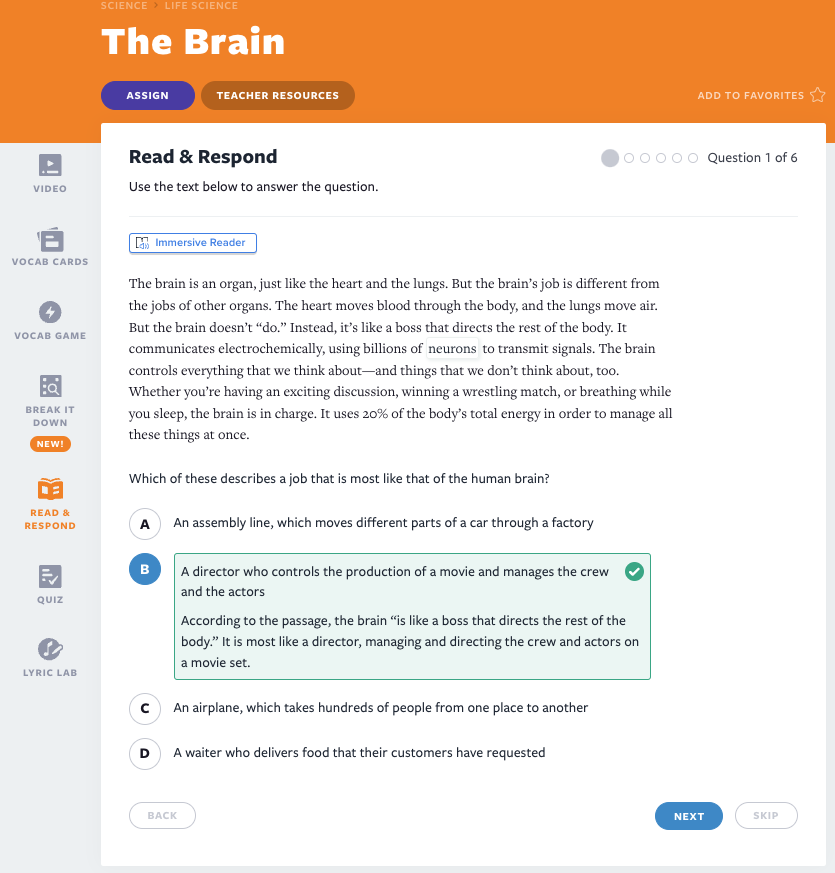
Read & Respond
Flocabulary’s Read & Respond includes reading passages that require students to read closely, look for key details, make inferences, analyze the author’s perspective, and identify the main point or idea. The reading passages provide more context on the topic, diving deeper into the subject. For example, Flocabulary’s video “The Brain” teaches students all about the brain, from its structure to its function. The Read & Respond passages elaborate on the information provided in the video, not only adding an extra layer of instruction but also giving students a chance to connect what they learned from the video to the passages.
When writing Read & Respond passages, we take into account grade level and standards. Students might also recognize that the vocabulary words they learned earlier reappear in the Read & Respond. This is intentional, as it provides another opportunity for vocabulary exposure and modeling of application. When students answer a question in a Read & Respond, they are given immediate feedback along with an explanation of why an answer choice is correct, with text evidence to support the answer. This strategy models to students ways to justify their answers and explain why it’s correct, tapping into higher-order thinking.
Quiz
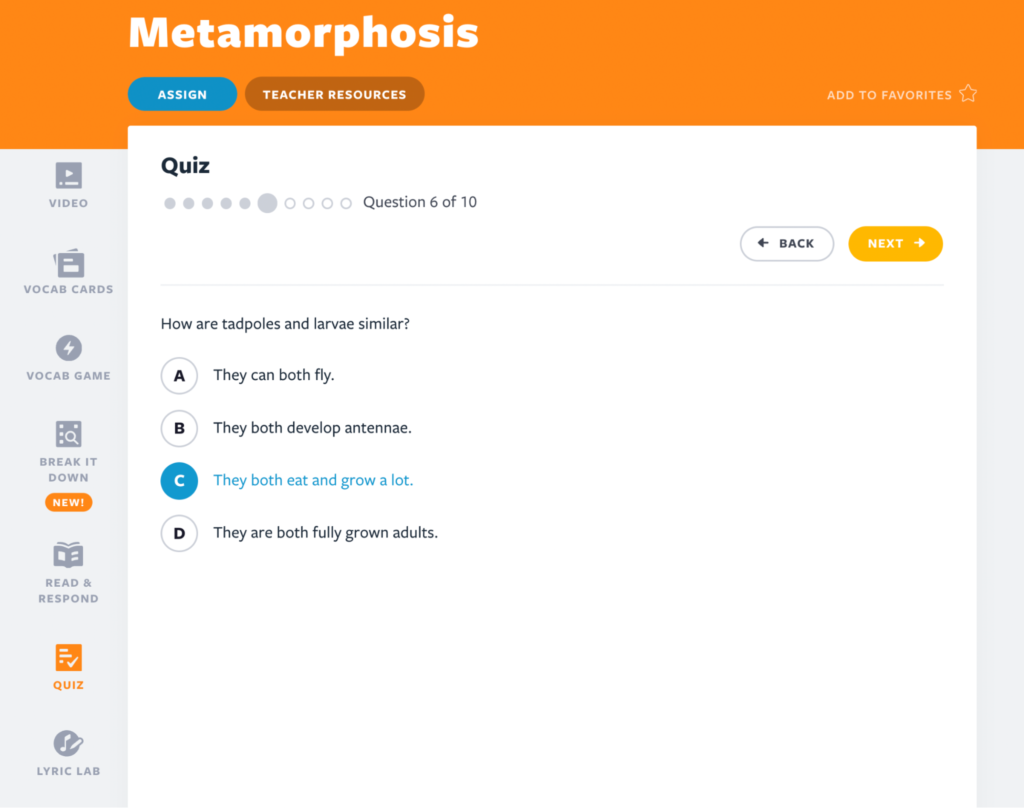
Next in the lesson sequence is the Quiz. Typically consisting of 10 multiple-choice questions, the Quiz checks for content comprehension, identification of key details and the main idea, and vocabulary knowledge. The Quiz acts as a quick assessment or exit ticket to ensure that students understand the video lesson. The Quiz questions are created to help students recall important details and analyze information from the video. For example, in Flocabulary’s science video “Metamorphosis,” the Quiz questions focus on the metamorphosis of frogs and butterflies, creating another opportunity for students to cement what they learned.
With an auto-grading feature, the Quiz is a great tool for gauging where extra attention might be needed as students apply what they learned from the video to answer the Quiz questions.
Lyric Lab
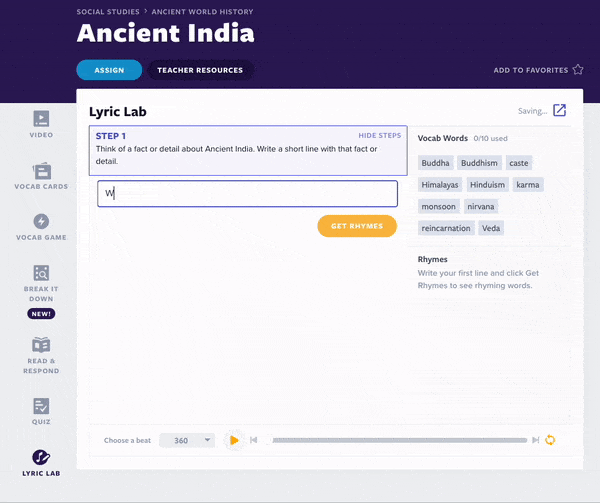
The final level of Bloom’s is “Create,” and Flocabulary’s Lyric Lab is the ultimate tool for helping students share their creativity while also demonstrating mastery of content. Lyric Lab provides students a platform for writing their own raps about the video content while also incorporating the vocabulary words learned. Students can choose their own beats and let their creativity shine through rhymes. There’s also a rhyming dictionary support feature where suggestions for rhyming words appear after a student writes the first line.
Lyric Lab is a great way to incorporate project-based learning into the classroom and create rapport as a community. Research shows that project-based learning not only gives students a sense of purpose but also helps them better retain content. Students can form smaller groups to write raps together and present them as a team. Teachers can also host a poetry slam or create a whole-class rap to perform for other classes. There are so many different ways Lyric Lab can be used in the classroom, and they all involve having students at the center of it all.
Start using Flocabulary today!
Here at Flocabulary, we believe in education that is accessible and engaging to all students. The activities in the lesson sequence can also be used for differentiated instruction and can be assigned based on skills that students need more support in. The activities in Flocabulary’s lesson sequence can be used as a whole-class lesson, a small-group lesson, in learning stations, or as an independent activity.
We also believe that teaching is the most important job in the world, and we’re committed to providing instructors with the most effective tools possible. Just as students are at the forefront of everything teachers do, we also carefully design our lessons with students and teachers as our priority.
New to Flocabulary? Teachers can sign up for a trial to access our lesson videos and assessment activities. Administrators can get in touch with us to learn more about unlocking the full power of Flocabulary through Flocabulary Plus.
